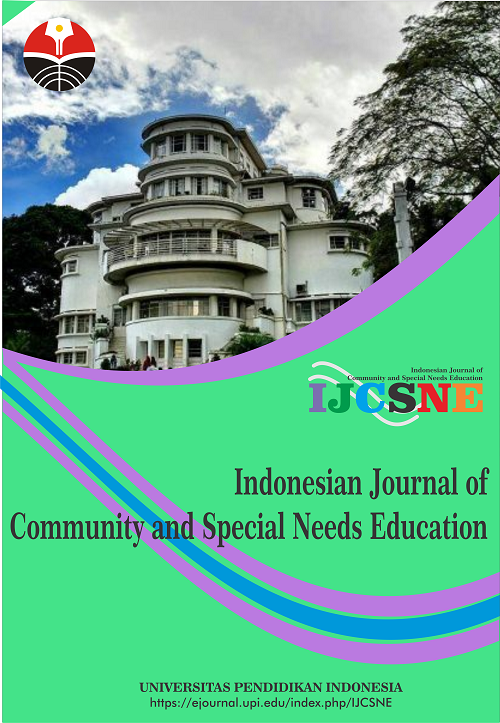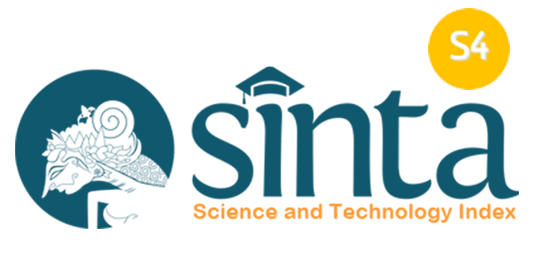Teachers' Challenges in Teaching English to Students with Special Needs: How to cope with them?
Abstract
Keywords
Full Text:
PDFReferences
Abells, D., Kirkham, Y. A., and Ornstein, M. P. (2016). Review of gynecologic and reproductive care for women with developmental disabilities. Current Opinion in Obstetrics and Gynecology, 28(5), 350-358.
Adi, S. S., Unsiah, F., and Fadhilah, D. (2017). Teaching special students: English lessons for deaf students in Indonesian special junior high schools. International Journal of Education and Research, 5(12), 121-136.
Apriliyanti, D. L. (2020). Enhancing teachers' competencies through professional development program: Challenges and benefits. Acuity: Journal of English Language Pedagogy, Literature and Culture, 5(1), 28-38.
Bakare, M. O. (2011). Autism spectrum disorders (ASD) in Africa: A perspective. African Journal of Psychiatry, 14(3), 208-210.
Bhuana, G. P., and Apriliyanti, D. L. (2021). Teachers’ encounter of online learning: Challenges and support system. Journal of English Education and Teaching, 5(1), 110-122.
Boyle, C., Topping, K., Jindal-Snape, D., and Norwich, B. (2012). The importance of peer-support for teaching staff when including children with special educational needs. School Psychology International, 33(2), 167-184.
Browder, D. G., Ahlgrim-Delzell, L., Courtade, G. R., Mraz, M., and Flowers, C. (2009). Literacy for students with severe developmental disabilities: What should we teach and what should we hope to achieve?. Remedial and Special Education, 30(5), 269-282.
Cooc, N. (2019). Teaching students with special needs: International trends in school capacity and the need for teacher professional development. Teaching and Teacher Education, 83, 27-41.
Ediyanto, E., Atika, I. N., Kawai, N., and Prabowo, E. (2017). Inclusive education in Indonesia from the perspective of widyaiswara in center for development and empowerment of teachers and education personnel of kindergartens and special education. Indonesian Journal of Disability Studies, 4(2), 104-116.
Estriyanto, Y., Kersten, S., Pardjono, P., and Sofyan, H. (2017). The missing productive vocational high school teacher competency standard in the Indonesian education system. Journal of Technical Education and Training, 9(1), 1-19.
Florian, L. (2019). On the necessary co-existence of special and inclusive education. International Journal of Inclusive Education, 23(7-8), 691-704.
Frick, P. J., and Nigg, J. T. (2012). Current issues in the diagnosis of attention deficit hyperactivity disorder, oppositional defiant disorder, and conduct disorder. Annual Review of Clinical Psychology, 8, 77-107.
Grzadzinski, R., Huerta, M., and Lord, C. (2013). DSM-5 and autism spectrum disorders (ASDs): An opportunity for identifying ASD subtypes. Molecular Autism, 4(1), 1-6.
Hughes, M., and Greenhough, P. (2006). Boxes, bags and videotape: enhancing home–school communication through knowledge exchange activities. Educational Review, 58(4), 471-487.
Jambor, E., and Elliott, M. (2005). Self-esteem and coping strategies among deaf students. Journal of Deaf Studies and Deaf Education, 10(1), 63-81.
Jobling, A., and Moni, K. B. (2004). ‘I never imagined I’d have to teach these children’: Providing authentic learning experiences for secondary pre‐service teachers in teaching students with special needs. Asia‐Pacific Journal of Teacher Education, 32(1), 5-22.
Khasawneh, M. A. (2021). Problems teaching english to deaf students. Indonesian Journal of Creative Counseling, 1(2), 32-42.
Koster, M., Pijl, S. J., Nakken, H., and Van Houten, E. (2010). Social participation of students with special needs in regular primary education in the Netherlands. International Journal of Disability, Development and Education, 57(1), 59-75.
Larson, S. A., Lakin, K. C., Anderson, L., Kwak Lee, N., Lee, J. H., and Anderson, D. (2001). Prevalence of mental retardation and developmental disabilities: Estimates from the 1994/1995 national health interview survey disability supplements. American Journal on Mental Retardation, 106(3), 231-252.
Lieberman, L. J., Lepore, M., Lepore-Stevens, M., and Ball, L. (2019). Physical education for children with visual impairment or blindnes. Journal of Physical Education, Recreation and Dance, 90(1), 30-38.
Linzalone, R., Schiuma, G., and Ammirato, S. (2020). Connecting universities with entrepreneurship through digital learning platform: Functional requirements and education-based knowledge exchange activities. International Journal of Entrepreneurial Behavior and Research, 26(7), 1525-1545.
Lohman, M. C., and Woolf, N. H. (2001). Self-initiated learning activities of experienced public school teachers: Methods, sources, and relevant organizational influences. Teachers and Teaching, 7(1), 59-74.
Meynert, M. J. (2014). Inclusive education and perceptions of learning facilitators of children with special needs in a school in Sweden. International Journal of Special Education, 29(2), 35-52.
Miranda, J. L., Wells, J. C., and Jenkins, A. (2019). Preparing special education teacher candidates to teach English language learners with disabilities: How well are we doing?. Language Teaching Research, 23(3), 330-351.
Norwich, B., and Lewis, A. (2007). How specialized is teaching children with disabilities and difficulties?. Journal of Curriculum Studies, 39(2), 127-150.
Pardini, D. A., and Fite, P. J. (2010). Symptoms of conduct disorder, oppositional defiant disorder, attention-deficit/hyperactivity disorder, and callous-unemotional traits as unique predictors of psychosocial maladjustment in boys: Advancing an evidence base for DSM-V. Journal of the American Academy of Child and Adolescent Psychiatry, 49(11), 1134-1144.
Putri, R. P., and Putro, B. H. (2021). Learning dance to improve motor skills of lightweight palsy cerebral patients at YPAC Semarang. Jurnal Pendidikan Indonesia, 2(03), 493-501.
Sharma, U., Forlin, C., Deppeler, J., and Yang, G. X. (2013). Reforming teacher education for inclusion in developing countries in the Asia Pacific region. Asian Journal of Inclusive Education, 1(1), 3-16.
Sharma, U., Forlin, C., Loreman, T., and Earle, C. (2006). Pre-Service teachers' attitudes, concerns and sentiments about inclusive education: An international comparison of novice pre-service teachers. International Journal of Special Education, 21(2), 80-93.
Suryani, L., Apriliyanti, D. L., and Rohmat, F. N. (2021). Developing teaching guidelines and learning module of speaking for general communication: Students’ perception and needs. Acuity: Journal of English Language Pedagogy, Literature and Culture, 6(2), 84-95.
Taylor, R. W. (2010). The role of teacher education programs in creating culturally competent teachers: A moral imperative for ensuring the academic success of diverse student populations. Multicultural Education, 17(3), 24-28.
Vaughn, S., Mathes, P. G., Linan‐Thompson, S., and Francis, D. J. (2005). Teaching english language learners at risk for reading disabilities to read: Putting research into practice. Learning Disabilities Research and Practice, 20(1), 58-67.
Zigmond, N., Kloo, A., and Volonino, V. (2009). What, where, and how? Special education in the climate of full inclusion. Exceptionality, 17(4), 189-204.
Zohoorian, Z., Zeraatpishe, M., and Matin sadr, N. (2021). Effectiveness of the picture exchange communication system in teaching english vocabulary in children with autism spectrum disorders: A single-subject study. Cogent Education, 8(1), 1-16.
DOI: https://doi.org/10.17509/ijcsne.v3i2.56869
Refbacks
- There are currently no refbacks.
Copyright (c) 2023 Universitas Pendidikan Indonesia

This work is licensed under a Creative Commons Attribution-ShareAlike 4.0 International License.















